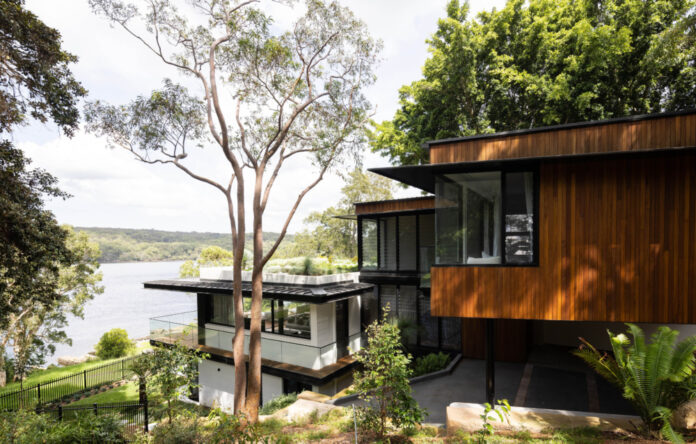[ad_1]
An Elevated 1960s Brick Home With Waterfront Sydney Views
Architecture

A pragmatic, rectangular formed home built for an engineer in 1965 and fronting the Port Hacking waterway has been reconfigured to sit comfortably in its bushland setting. Landscape design by Amrock Landscapes & Pools. Photo – Simon Whitbread. Interior decoration and styling – The Stables

Watershed Architects elevated the existing home by adding a new timber pavilion that ‘floats’ above the masonry structure on the sloping site. Landscape design by Amrock Landscapes & Pools. Photo – Simon Whitbread. Interior decoration and styling – The Stables

Australian hardwood cladding was chosen for the exterior to deliberately contrast the original masonry building. Photo – Simon Whitbread. Interior decoration and styling – The Stables

The formerly narrow balcony was widened to allow for a barbecue, dining table and lounge area to better appreciate the home’s water views. Landscape design by Amrock Landscapes & Pools. Photo – Simon Whitbread. Interior decoration and styling – The Stables

The new pavilion is positioned as an ‘arrival statement’ located at the end of the long and steep driveway, while creating a covered entry area underneath and access down to the waterfront. Photo – Simon Whitbread. Interior decoration and styling – The Stables

Large sliding doors open to the outdoors inclusive of a new terrace and pool below. Landscape design by Amrock Landscapes & Pools. Photo – Simon Whitbread. Interior decoration and styling – The Stables

The balcony is now the prime spot to take in the home’s water views. Photo – Simon Whitbread. Interior decoration and styling – The Stables

The kitchen was opened up to create an open-plan living domain. Photo – Simon Whitbread. Interior decoration and styling – The Stables

Photo – Simon Whitbread. Interior decoration and styling – The Stables

The peaceful home offers privacy with a connection to the unique natural setting. Photo – Simon Whitbread. Interior decoration and styling – The Stables

A new concrete roof sits atop the original structure. ‘By exposing the underside of the slab in the open plan living space below we were able to maximise the ceiling height and introduce a textural element to the space,’ says Carolyn Miles, director of Watershed Architects. Photo – Simon Whitbread. Interior decoration and styling – The Stables

The interior view of the new rooftop garden. Landscape design by Amrock Landscapes & Pools. Photo – Simon Whitbread. Interior decoration and styling – The Stables

The owners say the updated home offers a better seamless transition between levels. Photo – Simon Whitbread. Interior decoration and styling – The Stables

Bathrooms are light and contemporary. Photo – Simon Whitbread. Interior decoration and styling – The Stables

The bushland setting is framed throughout. Photo – Simon Whitbread. Interior decoration and styling – The Stables
This solid brick house in Lilli Pilli, in Sydney’s Sutherland Shire, was originally built in 1965 for an engineer. The building remained structurally sound, but was no longer fit for purpose as a family home due to its enclosed and small spaces.
‘It was a functional, no nonsense two storey box. It was well located on the site and offered good bones to work with,’ says Carolyn Miles, director of Watershed Architects, who recently transformed the house. ‘The internal spaces were small and lacked the connectedness that we value today, especially in relation to the outdoors in the form of a usable balcony.’
In renovating and extending the home, Watershed Architects retained as much of the existing brick and concrete structure as possible, and added a timber pavilion above on the sloping site.
‘Stepping the new addition back up the hill from the original structure and floating it above the ground allows an appreciation of the landform that slopes all the way down to the Port Hacking waterfront,’ says Carolyn.
Australian hardwood cladding was chosen for the exterior to deliberately contrast the original masonry building. ‘It seemed like a logical choice given the surrounding trees and the lighter, “floating” feel we were after,’ says Carolyn.
The new pavilion is positioned as an ‘arrival statement’ located at the end of the long and steep driveway, while creating a covered entry area underneath and access down to the waterfront. The interiors contain three new bedrooms and provide access to a new concrete roof atop the original home.
‘We chose a new concrete roof for the existing structure because it would best support a roof garden, require little to no maintenance, and contribute to the excellent thermal mass of the home,’ says Carolyn. ‘By exposing the underside of the slab in the open plan living space below, we were able to maximise the ceiling height and introduce a textural element to the space.’
The formerly narrow balcony was also widened to allow for a barbecue, dining table and lounge area to better appreciate the home’s water views. Large sliding doors on both levels open to the outdoors inclusive of a new terrace and pool below.
The owners say the updated home offers a better transition between levels that embraces the surrounding environment. The quality of the structure is equipped to deal with the coastal climate and offers choice over the degree of openness or privacy desired.
[ad_2]
thedesignfiles.net










